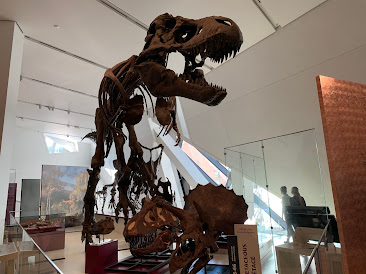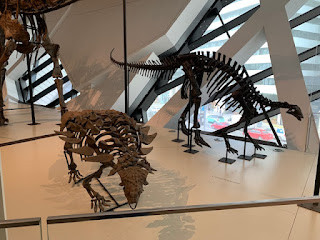Museum and Exhibit Virtual Tour and Review: Royal Ontario Museum
For the weekend of my birthday (despite really wanting it on my birthday), me and my wonderful mother headed to my stomping grounds, the Royal Ontario Museum in downtown Toronto, Ontario, Canada. The whole museum encompasses a whole lot of subjects, from ancient and world cultures, canadian history and Indigenous Cultures of it, ecosystems and animals (they have a cool walkthrough bat cave diorama for instance), and geology. However, what we're here to discuss is its palaeontology galleries. Respectively known as the James and Louise Temerty Galleries of the Age of Dinosaurs and Reed Gallery of the Age of Mammals, these two opened as part of a 2007 renovation that added the iconic "crystals" that look out onto the streets. Anytime I passed by them being driven by since I was a kid, I always tried to get a glimpse of the dinosaur skeletons through the glass, and begged my parents for a visit. But enough nostalgic waxing. Let's walk through the ROM's prehistoric galleries.
(Do note that I've been to the museum plenty of times before, so a good chunk of photos here are taken from earlier visits (October 25 2020 for instance); they're marked as p for prior).
The fossils of the museum are actually at the very start of the museum in its atriums. The first and most obvious is a cast mount of the titanosaur Futalognkosaurus in its Gloria Chen Court. No matter how many times I visit, the sheer size of it and the upper angle always leaves me in awe, and no doubt anyone else too. Its enough to make you think it has always been here, and was never intended to be merely a temporary installation for 2011 temporary exhibit Ultimate Dinosaurs, meaning this .
 |
| p |
 |
| p |
 |
| p |
While there are two other entrances to the halls, the main one is up a staircase relatively close to the entrance. Its here you'll notice murals by fellow canuck Julius T. Csotonyi, who also did artwork for many other museums and ROM projects. They're very good is what I'm saying.
The first thing you see when you enter the gallery is a display for marine life of the Jurassic. Course, going left brings you to an overlook bringing you face to face with the Quetz. With the Futalognkosaurus and other parts of the museum there, it makes for quite a backdrop. On the wall is a timescale of prehistory.
The rest of the left side for marine life is dominated by one clade: ichthyosaurs. Many are casts and not worth discussing, but then you huge original specimens of long-snouted Eurhinosaurus and of Excalibosaurus, which the signage notes was extracted from the rock just like King Arthur's sword. Clever and funny, that is.
 |
| p Note the Temodontosaurus cast below too |
 |
| p |
 |
| p |
The right side of the gallery, meanwhile, is dedicated to cretaceous fauna, particularly those of the famous Dinosaur Park Formation in Alberta. It starts off with a cast of Deinonychus and Gorgosaurus (labled as Albertosaurus libratus), which like a good chunk of the mounts, a mix of casts and real fossil specimens. Next is Dromaeosaurus. Then comes a cast of Anzu, one of the more recent additions, and Ornithomimus.
 |
| p |
Then, around the corner (after a case of fossil insects from Brazil's Santana Formation) comes a very good collection of hadrosaur specimens. You have a big head of an Edmontosaurus, standing mounts of Maiasaura and of course babies, and mounts of Corythosaurus and Lambeosaurus and cabiets showing how their crests grew throughout their lives, as well as a trackway of relatives from British Columbia 120 million years ago. However, I'd be remiss not to mention the last one on show here, the holotype of Parasaurolophus, in a wall mount much at it was for decades.
 |
| p |
On a note of speculation, with how is positioned directly across from Gordo, I can't help but wonder if it was positioned so visitors could compare it the taxa, especially in teeth.
Above are two pterosaurs, specifically Geosternbergia.
 |
| p |
For a while there were the token two Triassic dinosaur specimens located beyond the gallery. Its a small corridor coming from a hall for events and has a washroom. In it were casts of Herrasaurus and a basal sauropodmorph I believe was Massospondylus, but intriguingly there was also a specimen of a sea scorpion or eurypterid.
 |
| p |
 |
| p |
 |
| p |
However, on my visit it was no more. Instead, the museum has for a while ben renovating the space into a new gallery for Palaeozoic life, called the Dawn of Life gallery. In fact, the scorpion acted as a preview of such. Given that the Palaeozoic isn't all that represented in both the museum and among th public, its a welcome addition.
Oh, and in the furthest corner of the gallery there's a parksosaur in a glass case with displays on fossil excavation. Moving on.
 |
| p |
To cross over to the other galleries in another crystal, one goes through a walkway. You emerge face to face with who else but Tyrannosaurus rex mid-stride. This isn't a real one though, instead being a cast of the famous Wankel/Nation's Rex. However, its not the first exhibit here. Instead, that goes to a section for marine life (which fills the Aquatober quotient for the entry).
The best thing about the latter display of the Xiphactinus and Archelon above is that if you look at the top, you might notice a fish coffin from west Africa in the museum's world culture gallery on the third floor. Funny thematic connection there.
The T. rex's island is dedicated to the Maastrichtian and its fauna, particularly the ceratopsids. At the rex's feet are various skulls of both them and tyrannosaurs, also especially those from the Dinosaur Park Formation, such as....
 |
| Protoceratops from front isn't alive it can't hurt you Protoceratops from front: |
The Reed Gallery of the Age of Mammals is a bit more labyrinthine in design, consisting of islands each representing a different part of the Cenozoic and all very densely packed. To be honest, I can't really remember it as well as the dinosaurs, so I honestly won't comment too much on them now and might reserve it for a future entry. However, I will say the huge amount of taxa in it is quite good, like a Desmostylian. There's also the only known fossil of the extinct deer Torontoceros. Guess where its from. You also have a ton of other neat stuff, like displays on coral and amber, the history of a fossil. Now here's a slideshow of my favourites from it:
 |
| p |
 |
| p |
 |
| p |
 |
| p |
 |
| p |
 |
| p |
 |
| p |
 |
| p |
The galleries conclude with an exhibit for Wendiceratops that opened in 2015 and is still going on. Not much worth discussing here.
 |
| p |
So what do I think of the ROM? Well putting aside its my hometown museum and the one I visit the most and thus has most personal value, pretty good. Now in all honesty I haven't really visited any other major museums besides Chicago's Field Museum, but I haven't been there in years, so its kind of my base level. The mounts are all good, the displays are relatively simple but understandable, and the whole space is wide yet intimate. More recently, interactive interpretives with art by Julius have also been added for certain mounts (Gordo, Parasaurolophus, rex, ground sloth, and mastodon), which is a good way to draw more attention to them and provide more up to date info.
Arguably my favourite part about the exhibit is that the signage has pictures of what parts are actual fossils and what are casts. This is something a few other museums to my knowledge do, like the Carnegie and the Field Museum, but I'm quite sure more need to do. Many a museum-goer needs to understand that not everything they see are real fossils, and those need to be off display for study or any other purposes.
Now however, there are a few problems I do with it, minor as they may be.
- Being nearly 15 years old, some of the mounts are outdated in some ways. For instance, many of the theropods have pronated or semi-pronated hands, and the stegosaurus should not be the high-backed, short-necked and arm creature it is. A refurbishment could correct it with moderate to little effort.
- Meanwhile, I've read the gallery relies too much on the natural light from the windows, and its a problem on cloudier days.
- The rather minimalistic white design of the galleries is not engaging for the eyes, save for some a few strips here and there and flat backdrops in the mammal area. Its worse as before the renovation, the fossils were in habitat immersion dioramas, as seen here. To be honest, I prefer dioramas to the current thing, as it can contexualise them in their palaeo-environments. The mammals fair a bit better, with some having backdrops of stock images (like the South American ones), and as will be seen with the Dawn of Life gallery, large paintings by Julius will have more to it.
See Also
- Gordo the Barosaurus, an article I wrote for Atlas Obscura outlining his history





















Comments
Post a Comment